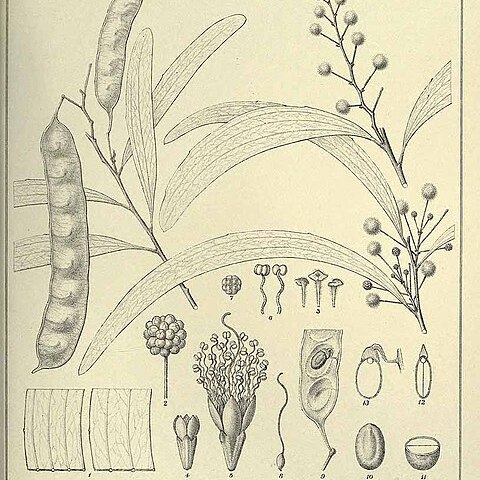Shrub or tree 3–10 m high. Bark rough, brown or dark grey. Branchlets glabrous. Phyllodes narrowly elliptic to narrowly oblong-elliptic or ±linear, sometimes tending oblanceolate, commonly falcately recurved, 8–26 cm long, 0.5–2 cm wide, narrowed at base, obtuse, glabrous, with 2 distant main longitudinal veins and openly reticulate between them; glands 3 or 4, with one basal and secondary ones often projecting slightly from margin; pulvinus 2–4 mm long. Inflorescences 4–11-headed racemes; raceme axes 10–30 mm long, glabrous; peduncles 6–17 mm long, glabrous; heads globular, 4–6 mm diam., 30–55-flowered, cream to pale yellow; bracteoles peltate. Flowers 5-merous; sepals ⅔–¾-united; petals ±glabrous. Pods mostly narrowly oblong and flat, to 15 cm long, 12–15 mm wide, coriaceous, finely and openly reticulate, glabrous. Seeds longitudinal to oblique, oblong, 8–10 mm long, dull, black; aril apical, small.
More
A slender tree up to 5-8 m high. It has a narrow crown. It can be 3-4 m across. The small branches hang downwards. The leaves (phyllodes) also hang downwards. The bark is rough and dark brown to black. The leaves are smooth, narrow and slightly curved. They are 10-20 cm long by 0.5-2 cm wide. They are dark green. Two or 3 raised veins run along the leaf. The flowers are cream and on balls. They are 0.5 cm across. Several flowers occur together on short stalks in the angles of leaves. The pod is smooth and straight. It is 12-18 cm long and 1.2-2 cm wide. The pods are pale brown when ripe. They are slightly woody. They are flat and with prominent edges. They contain several black seeds.


